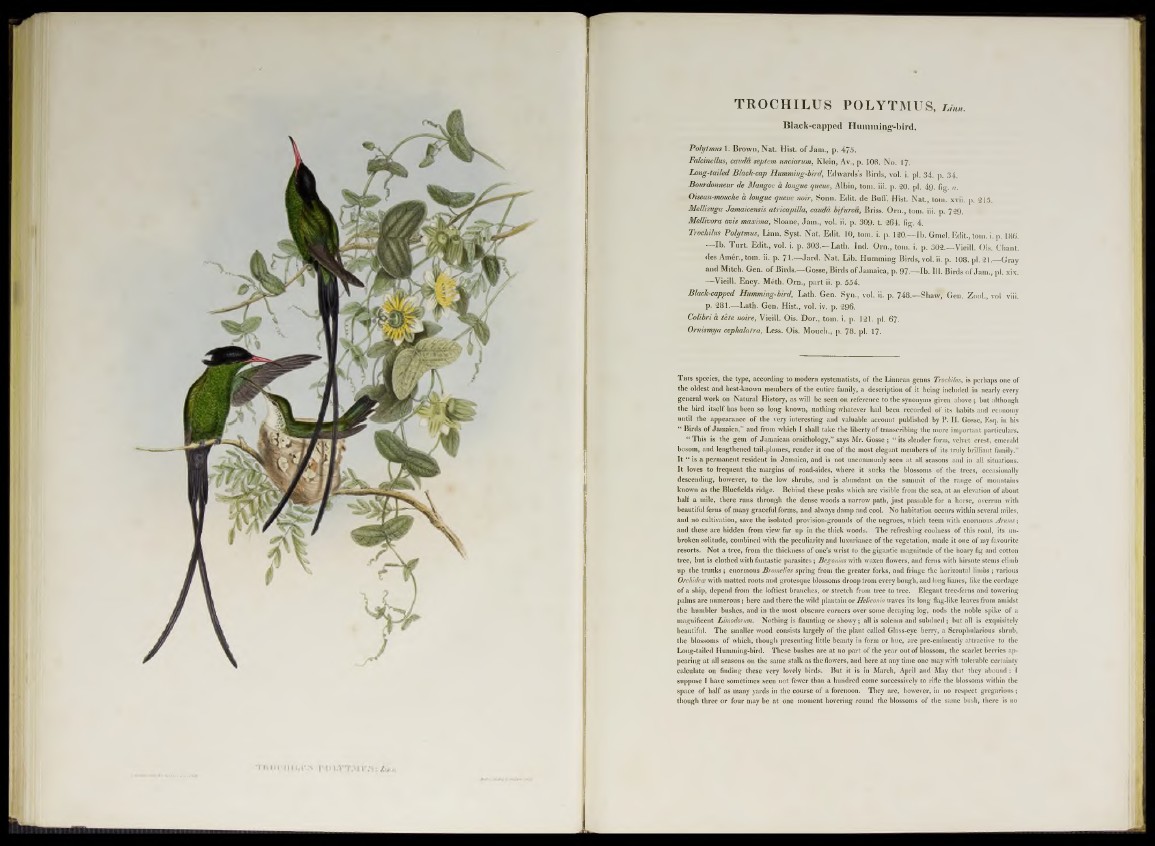
TROCHILUS POLYTMUS, im n .
Black-capped Humming’-bird.
Polytmus 1. Brown, Nat. Hist. of Jam., p. 475.
Falcinelhis, cauda septem unciarum, Klein, Av., p. 108. No. 17.
Long-tailed Black-cap Humming-bird, Edwards’s Birds, vol. i. pl. 34. p. 34.
Bourdonneur de Mangoe a longue queue, Albin, tom. iii. p. 20. pl. 49. fig. «.
Oiseau-mouche a longue queue noir, Sonn. Edit. de Buff. Hist. Nat., tom. xvii. p. 215.
Mellisuga Jamaicensis atricapilla, cauda, bifurca, Briss. Orn., tom. iii. p. 729.
Mellivora avis maxima, Sloane, Jam., vol. ii. p. 309. t. 264. fig. 4.
Trochilus Polytmus, Linn. Syst. Nat. Edit. 10, tom. i. p. 120.—Ib. Gmel. Edit., tom. i. p. 186.
||g g |I b . Turt. Edit., vol. i. p. 303.—Lath. Ind. Orn., tom. i. p. 302.—Vieill. Ois. Chant.
des Amér., tom. ii. p. 71.—Jard. Nat. Lib. Humming Birds, vol. ii. p. 108. pl. 21.—Gray
and Mitch. Gen. of Birds.—Gosse, Birds o f Jamaica, p. 97-— Ib. 111. Birds of Jam., pl. xix.
—Vieill. Ency. Méth. Orn., part ii. p. 554.
Black-capped Humming-bird, Lath. Gen. Syn., vol. ii. p. 748.—Shaw, Gen. Zool., vol viii.
p. 281.—Lath. Gen. Hist., vol. iv. p. 296.
Colibria tète noire, Vieill. Ois. Dor., tom. i. p. 121. pl. 67.
Ornismya cephalatra, Less. Ois. Mouch., p. 78. pl. 17.
T his species, the type, according to modern systematists, of the Linnean genus Trochilus, is perhaps one of
the oldest and best-known members of the entire family, a description of it being included in nearly every
general work on Natural History, as will be seen on reference to the synonyms given above ; but although
the bird itself has been so long known, nothing whatever had been recorded of its habits and economy
until the appearance of the very interesting and valuable account published by P. H. Gosse, Esq. in his
“ Birds of Jamaica,” and from wliich I shall take the libertyof transcribing the more important particulars.
“ This is the gem of Jamaican ornithology,” says Mr. Gosse ; “ its sleuder form, velvet crest, emerald
bosom, and lengthened tail-plumes, render it one of the most elegant members of its truly brilliant family.”
It “ is a permanent resident in Jamaica, and is not uncommonly seen at all seasons and in all situations.
It loves to frequent the margins of road-sides, where it sucks the blossoms of the trees, occasionally
descending, however, to the low shrubs, and is abundant on the summit of the range of mountains
known as the Bluefields ridge. Behind these peaks which are visible from the sea, at an elevation of about
half a mile, there runs through the dense woods a narrow path, just passable for a horse, overrun with
beautiful ferns of many graceful forms, and always damp and cool. No habitation occurs within several miles,
and no cultivation, save the isolated provision-grounds of the negroes, wbich teem with enormous Arums;
and these are hidden from view far up in the thick woods. The refreshing coolness of this road, its un-
broken solitude, combined with the peculiarity and luxuriance of the vegetation, made it one of my favourite
resorts. Not a tree, from the thickness of one’s wrist to the gigantic magnitude of the hoary fig and cotton
tree, but is clothed with fantastic parasites; Begonias with waxen flowers, and ferns with hirsute sterns climb
up the trunks; enormous Bromelias spring from the greater forks, and fringe the horizontal limbs ; various
Orchideas with matted roots and grotesque blossoms droop from every bough, and long lianes, like the cordage
of a ship, depend from the loftiest branches, or stretch from tree to tree. Elegant tree-ferns and towering
palms are numerous; here and there the wild plantain or Heliconiawaves its long fiag-like leaves from amidst
the humbler bushes, and in the most obscure corners over some decaying log, nods the noble spike of a
magnificent Lunodorum. Nothing is fiaunting or showy; all is solemn and subdued ; but all is exquisitely
beautiful. The smaller wood consists largely of the plant called Glass-eye berry, a Scrophularious shrub,
the blossoms of which, though presenting little beauty in form or hue, are pre-eminently attractive to the
Long-tailed Humming-bird. These bushes are at no part of the year out of blossom, the scarlet berries ap-
pearing at all seasons on the same stalk as the flowers, and here at any time one may with tolerable certainty
calculate on finding these very lovely birds. But it is in March, April and May that they abound: I
suppose I have sometimes seen not fewer than a hundred come successively to rifle the blossoms within the
space of half as many yards in the course of a forenoon. They are, however, in no respect gregarious;
though three or four may be at one moment hovering round the blossoms of the same bush, there is no